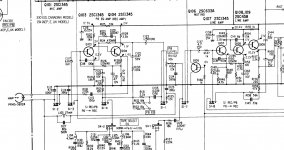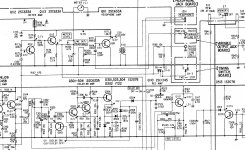I still use my pioneer CT91 almost every day. I also have another Yamaha 3 head machine as backup and also a Sony WMD6C for portable use. I love the tape compression you get when tracking drums on R2R, which is what my 2 Tascam 44s are mainly used for.
The old Sony TCK-5 (see post #2) turns in a surprisingly decent performance even today.
I recorded this 3 or 4 weeks back when I last fired it up. Sadly it sits wrapped up for months/years with just an occasional spin to keep it all in order and the caps formed. All original electrically. No recapping (yet).
This was recorded and played back with Dolby B engaged and the circuitry is all discrete on this oldie, no IC's apart from the motor servo, not even an opamp anywhere. BASF chrome tape. The file is 320kbps MP3
Enjoy 😉
I recorded this 3 or 4 weeks back when I last fired it up. Sadly it sits wrapped up for months/years with just an occasional spin to keep it all in order and the caps formed. All original electrically. No recapping (yet).
This was recorded and played back with Dolby B engaged and the circuitry is all discrete on this oldie, no IC's apart from the motor servo, not even an opamp anywhere. BASF chrome tape. The file is 320kbps MP3
Enjoy 😉
Attachments
Is this the one with protruding transformers at the back? If yes its difficult to work with indeed. I had one for service once. There's a top PCB that hides some cal trimmers also.
Sounds very good. I could also see healthy 14kHz content in Foobar's spectrum analyzer. Not bad at all. You kept the loading on the BASF moderate for that, up to 0dB peak it seems (?)The old Sony TCK-5 (see post #2) turns in a surprisingly decent performance even today.
I recorded this 3 or 4 weeks back when I last fired it up. Sadly it sits wrapped up for months/years with just an occasional spin to keep it all in order and the caps formed. All original electrically. No recapping (yet).
This was recorded and played back with Dolby B engaged and the circuitry is all discrete on this oldie, no IC's apart from the motor servo, not even an opamp anywhere. BASF chrome tape. The file is 320kbps MP3
Enjoy 😉
It might very well be that the original caps are better than today's best caps...just finished recapping an old telefunken...all the 40 years old nippon chemicon caps measure as new...and this deck was not used for at least 15 years ...Sadly it sits wrapped up for months/years with just an occasional spin to keep it all in order and the caps formed. All original electrically. No recapping (yet).
Yes, it's a lost technology since Atlantis got under watter...some of the old rubycon, sanyo, siemens or nippon chemicon were simply better than the new ones advertized for industrial heavy use.Shelf life wasn't mentioned 40 years ago...why would they tell you're guaranteed up to 30 years shelf life?!I measured 0.573Ω 100kHz ESR in 4.7uF/50V Nichicon VX pulled from a 35 years old deck when Panasonic FC spec is 1.3Ω for their 4.7/50 same 5X11mm size type!
View attachment 1074604
View attachment 1074605
Lost or cost? 🙂Yes, it's a lost technology since Atlantis got under watter...
Its also the 21V rail and higher bias few transistors than in op-amps contributing to the sense of dynamics I would think.Thanks 🙂 I didn't push the tape to hard at all. That discrete Dolby stage works really well I think, its simple but carefully designed. The variable headphone output uses a small coupling transformer.
^ Possibly so 🙂 It certainly sounds good even today and all the caps are original. I think I tested a couple about 8 years ago with a Tan Theta tester and they were better than some much newer ones I had in stock and which bears out what you have found.
I also have what would be the matching tuner of that period, the ST515L and that is all original as well.
I measured 0.573Ω 100kHz ESR in 4.7uF/50V Nichicon VX pulled from a 35 years old deck when Panasonic FC spec is 1.3Ω for their 4.7/50 same 5X11mm size type!
I also have what would be the matching tuner of that period, the ST515L and that is all original as well.
Very cool looking your tuner. 70's components had substantial chassis with lovely meters and scales, meaty sound. Hi-Fi's golden era. I have helped to restore and tune a Sony seven gang ST-A6B belonging to a friend. Very nice sound.
Thanks 🙂 The build quality of equipment from the 70's was wonderful, no doubt on that. Substantial chassis and 'hewn from solid' front panels.
The first cassette deck I had was a TC136SD top loader which partnered my first ever home built amp. The tuner was a Sony ST2950F which had a couple of analogue meters for tuning and signal strength. Not to dissimilar style wise to the ST-A6B you mention.
The TCK-5 and ST515 belonged to my parents.
Nice picture of the front end here:
http://www.thevintageknob.org/sony-ST-A6B.html
They don't make 'em like that anymore.
The first cassette deck I had was a TC136SD top loader which partnered my first ever home built amp. The tuner was a Sony ST2950F which had a couple of analogue meters for tuning and signal strength. Not to dissimilar style wise to the ST-A6B you mention.
The TCK-5 and ST515 belonged to my parents.
I have helped to restore and tune a Sony seven gang ST-A6B belonging to a friend. Very nice sound.
Nice picture of the front end here:
http://www.thevintageknob.org/sony-ST-A6B.html
They don't make 'em like that anymore.
I know it's common to record Dolby C on "deck a" (in my case a JVC in the 1990's) and when playing it back on "deck b" (in my case, the aformentioned Yamaha 592), the treble is lost if playing back with C. Surely that couldn't really be true?
What's the point of a "standard" if I can't play my tapes in your deck?
I heard you were supposed to play without dolby, just record with it, but that's also horsepoop, right?
What's the point of a "standard" if I can't play my tapes in your deck?
I heard you were supposed to play without dolby, just record with it, but that's also horsepoop, right?
When decks are carefully aligned with full track Dolby level and azimuth test tapes they don't show Dolby C incompatible behavior between them in my experience.
If they do show incompatibility after that then maybe their mechanical alignment needs to be checked with M300 gauge or there's substantial IEC curve deviation. Which can be remedied by measurements and modding the PB stage's EQ components.
If they do show incompatibility after that then maybe their mechanical alignment needs to be checked with M300 gauge or there's substantial IEC curve deviation. Which can be remedied by measurements and modding the PB stage's EQ components.
Any noise reduction system requires that the deck is aligned correctly because the way noise reduction works (using frequency dependent compression and expansion or companding) means that it is extremely sensitive to errors.
Slight head alignment or azimuth errors between decks will produce significant treble roll off. Also critical is the play back level of the signal entering the decoder if playing back a tape recorded on a different machine.
A correctly aligned deck whether using Dolby B or C should play back its own recording with absolutely correct tonal balance on the deck it was recorded on. It is unfortunately a fact that decks from different manufacturers seldom meet that requirement but on a diy level you can usually align a second deck to 'match' another so that there is pretty good compatibility. Azimuth and correct levels (the internal preset playback and preset record sensitivity levels are the most important things.
Slight head alignment or azimuth errors between decks will produce significant treble roll off. Also critical is the play back level of the signal entering the decoder if playing back a tape recorded on a different machine.
A correctly aligned deck whether using Dolby B or C should play back its own recording with absolutely correct tonal balance on the deck it was recorded on. It is unfortunately a fact that decks from different manufacturers seldom meet that requirement but on a diy level you can usually align a second deck to 'match' another so that there is pretty good compatibility. Azimuth and correct levels (the internal preset playback and preset record sensitivity levels are the most important things.
- Home
- Source & Line
- Analogue Source
- How Many Cassette Deck Users Here?

